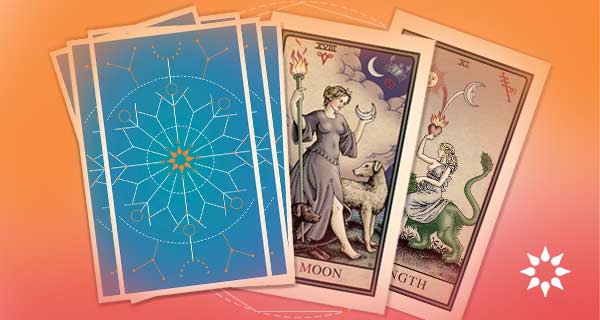As a practitioner of Tai Chi, I find myself becoming interested in all things related to Eastern thought. My Medium friend Diane and I have always read cards together, and come out with very accurate interpretations. She and I are, you might say, “card buddies.” Recently we both began reading the Chinese cards, and achieved what we thought were very good interpretations.
Most people know the Mah Jong as a tile-card game. Few realize, however, that these cards can be read as well. Unlike a regular Tarot deck, the Mah Jong Oracle has a total of 144 cards, which at first may seem overwhelming. However, we quickly learned that there are four sets of duplicate cards (34 cards each). Each set comprises three Suit cards (9 each), and seven Honors cards. Lastly, there are eight “Guardian” cards.
I love these Guardian cards. They offer help and guidance through difficult times. In essence, when a guardian card is drawn, it is always replaced by another card, so two cards end up occupying the spot of one. (One is “guarding” the other). The Guardian cards have beautiful names: Plum Blossom, Orchid, Chrysanthemum, Bamboo, Fisherman, Woodcutter, Farmer and Scholar. These cards are meant to represent the seasons, and seasonal occupations. In Chinese painting, the Plum Blossom, Orchid, Chrysanthemum and Bamboo are known as the “Four Nobles” – exquisite examples representing the four seasons. The four occupations represent humble-yet-honest callings (the Fisherman, the Woodcutter, the Farmer and the Scholar). In traditional Chinese folklore, it is believed that four mortals from these occupations were transported to the celestial realm because of their pious work ethics.
The three suits are as follows: Bamboo, Circles and Wan.
The Bamboo suit is involved with refinement and tranquility – essentially, inner happiness. This suit represents family relationships and health. The Bamboo suit teaches patience and understanding. The Willow, which is number nine in the Bamboo suit, displays strength through flexibility. The Duck, Number 2, demonstrates the quality in a steady partnership, whether it is a business or a marital union.
The next suit is that of Circles, which was the first suit in the Mah Jong tiles. The Circle, of course, is the symbol that most replicates nature, and circles are seen in all religions – old and new. This suit is concerned with business and money, much like the Pentacles in a Tarot deck. And as with Tarot cards, the Mah Jong cards are interpreted depending on the question being asked. For instance, if someone were to ask about love, it would be important that the 2, 6 and 8 Circles be present. These are Pine (2), Peach (6), and Tiger (8). The pine usually represents a young man – lover or brother or friend – with the strength and firmness of a pine tree. The Peach represents a young woman, with the softness and fragrance and velvety texture of a peach. The Tiger symbolizes authority, masculinity, bravery and aggression. This usually represents an authority figure.
The next suit is that of Wan, representing abstract concepts such as the visionary, the theorist and the perfectionist. These are individuals who value academic achievements – and the fulfillment of ideals – over the mundane aspects of everyday life. Wan, in Chinese, means ten thousand, which can be translated to mean any large number. For instance “ten thousand things” can mean the entire universe, while “ten thousand people” can represent everyone in the world.
In readings, a high number of Wan cards would generally mean the querent would be disappointed in their answer. As an example, if they are asking about romance, the Sword (2) and Knot (8) would represent severing the relationship. If there are a large representation of circle cards without these three, it is demonstrating that priorities are not in the right order, and the querent should reconsider the partnership.
Read part two of Ariel’s Mah Jong series here.


One thought on “How To Read Mah Jong”
Hello Thanks and glad to know your site
My concern—can individual or person read for himself(mahjong 144 cards)
your response is highly appreciated.